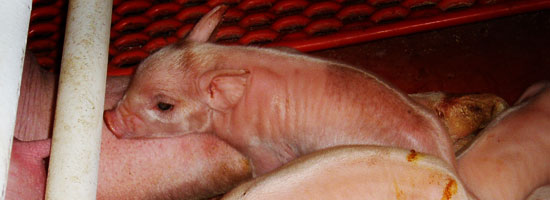Recently, several eradication methods to reproduce PRRSV-negative farms have been developed and successfully applied to breeding herds. Whole herd depopulation/repopulation has been proven to be effective for elimination of a wide range of pathogens in swine. While it is possible to eradicate PRRSV by using this strategy, the significant disadvantage of this method is the cost and the inability to preserve genetics and established parity structures in the herd. Therefore, this strategy may be the ideal method for relatively small scale commercial herds that have been experiencing multiple infectious disease problems including PRRS, but not applicable for seed stock companies.
Table 1: Effective methods for the eradication of PRRS
Whole herd depopulation & repopulation
Herd closure
Herd closure plus serum inoculation
Herd closure plus vaccination
Test and removal
Segregated early weaning and restocking
Successful elimination of PRRSV by test and removal has been described in a number of commercial seed stock farms. The primary focus of this strategy is to test all breeding animals, identify carriers (persistently infected animals), and remove them from the herd, resulting in prevention of vertical transmission of PRRSV. Analysis of sera by ELISA for the detection of antibodies, along with the use of PCR for the detection of viral nucleic acid, can be used in combination to identify the animals that should be removed. While the test and removal is very effective, this strategy has a number of disadvantages including a high diagnostic cost ($10 U.S. per sow tested), extensive labor on testing days, and premature removal of potentially PRRSV-negative sows due to the inability of the ELISA to distinguish chronic carrier from those previously infected that have already cleared the virus. Finally, it is impossible at this point to distinguish vaccinated animals from naturally infected animals due to a lack of differentiate serological testing. Therefore, the efficacy of this strategy in vaccinated herds is unknown at this time.

Preventing vertical and horizontal spread of PRRSV from dam to offspring is critical for the production of naive replacement stock
Herd closure is the primary means of eradication applied today and is highly successful This strategy is based on the theory of preventing the entry of replacement gilts for an extended period of time (8-12 months), stabilizing the infection within the endemically infected breeding herd, and removing carriers over time following normal culling procedures. Naïve replacement animals are introduced into the breeding herd following the closure period. Prior to the introduction of the naive replacement gilts, sentinel animals are used as an indication of a lack of transmission within the breeding herd. The advantage of this strategy would be preservation of genetic material and reduce the diagnostic cost and labor, when compared to test and removal. However, the main disadvantage of herd closure would be the economical loss due to the extended breeding period without the availability of replacement gilts, and the destruction of the herd parity distribution. Although these issues are easily solved by using an off-site breeding project, this also requires extra cost including labor and facilities..
Finally, following cessation of vertical/horizontal transmission of PRRSV from dam to her offspring in the breeding herd, partial (nursery/finisher) depopulation is also an essential part of PRRS eradication from the growing pig population. This method involves the confirmation of PRRSV circulation in the nursery pig population, the removal of the population to an off-site facility, cleaning, disinfection and downtime of 1-2 days, followed by re-stocking. The advantages of partial depopulation are improved post-weaning mortality, growing rate, feed efficiency, and lower antibiotics/vaccine cost. It also requires minimal disruption in pig flow, although off-site facilities to house depopulated pigs are necessary.




